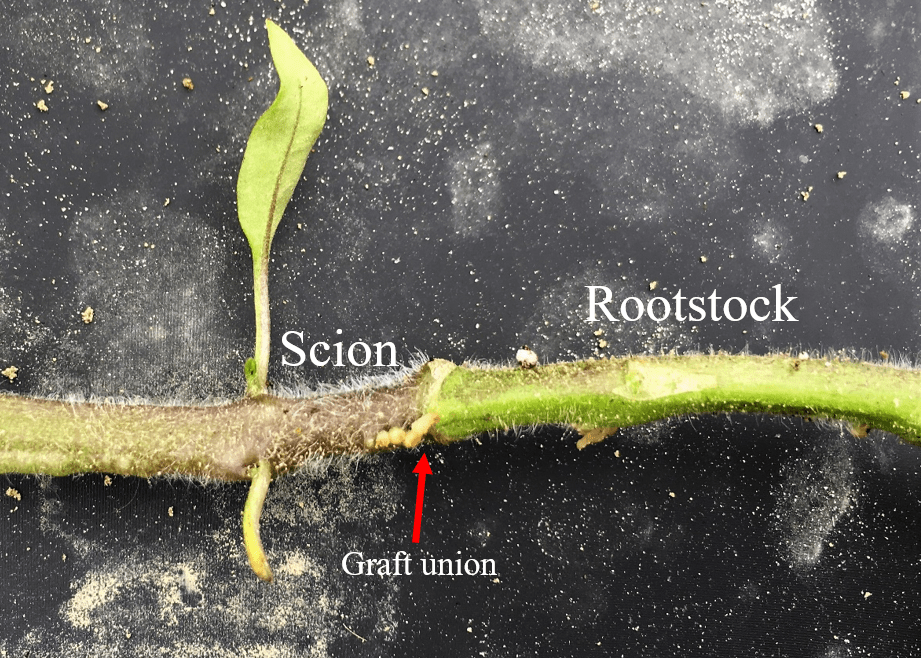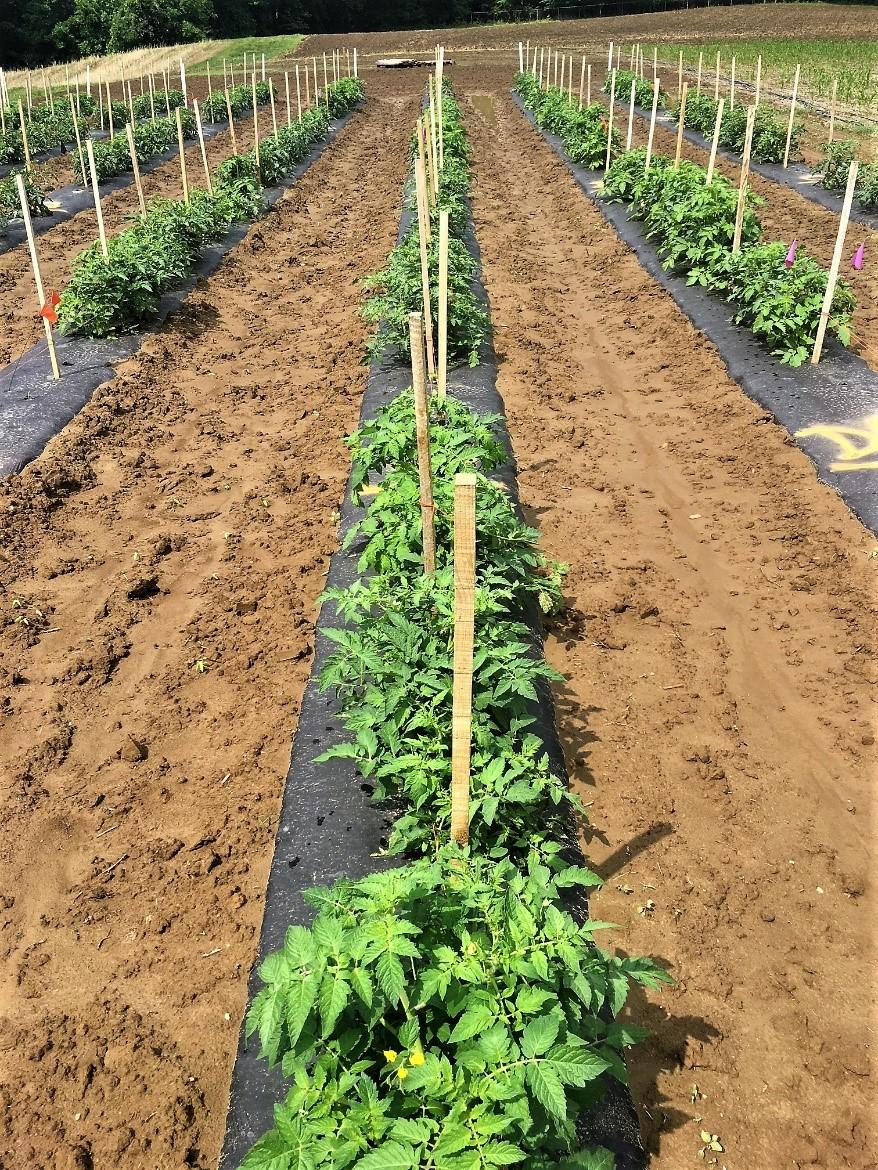Does it Pay to Graft Tomatoes for Increased Yields When There are No Soil Disease Problems
Tomatoes are grafted by joining the top part of one plant (the scion) to the root system of another plant (the rootstock) (fig. 1). The resulting plant is usually more vigorous and productive. Many studies have been conducted over the last 10 years that show the benefits of using grafting for soil disease control in tomato production, but there is not much research that examines the influence of rootstocks in no disease field tomato production systems. In general, vegetable grafting can increase yield by improving crop tolerance to abiotic stresses because of the plant’s ability to increase water and nutrient uptake via a more vigorous rootstock. I looked at what would be the benefit, if any, of grafting four different tomato varieties into a field that had not had any vegetables in it for at least 4 years and had no history of soil disease problems. The varieties were: Red Deuce, Red Mountain, Big Beef and Mt. Fresh+ onto the rootstock of Maxifort.
Methods: Grafting treatments consisted of two combinations: a scion/rootstock graft and a non-grafted control using the same variety. Approximately seven weeks after grafting, all grafted and non-grafted seedlings were transplanted into the field on 3rd May, 2019. Before transplanting the field was fertilized and black plastic mulch with drip irrigation was laid forming 8 rows 100 ft long. There were three replications of 10 tomatoes of each variety grafted and 10 plants non-grafted spaced 2 ft apart within a row (fig. 2). Eight harvests took place starting on July 9 and continuing on July 12, 15, 18, 23, 29 and Aug. 1 and 8. Yields were subjected to a 2-factor ANOVA looking at variety (4) by grafted or not (2) and means were separated using Tukey HSD test. ANOVAs with p values equal to or less than 0.05 were considered significant as were mean separation tests.
Leaf tissue samples were taken at first flower bud and every two weeks throughout the study. Fruit harvests were conducted two-three times per week and separated into marketable and non-marketable fruit. Non-marketable fruit categories consisted of yellow shoulders, uneven ripening, cat-facing, blossom end rot, fruit cracking and ‘other’. Fruit number and weight were recorded.
Results: Overall the total marketable fruit weight for grafted plants (mean of 15.2 lbs/plant) had significantly greater yields compared with non-grafted plants (13.7 lbs/plant). All varieties that were grafted had on average 11% more marketable fruit compared with their non-grafted variety. Early yields (9 and 12 of July) showed no differences between grafted and non-grafted plants for any of the varieties, although the variety Red Mt. significantly out yielded Big Beef and Mt Fresh+ by almost 93%. For the main harvests (15-29 of July) grafted plants were significantly greater in marketable yields (13.3 lbs/plants) compared with non-grafted plants (11.8 lbs/plant). There was a significant difference between three of the varieties (overall mean of 12.9 lbs/plant) vs. Mt. Fresh+ (11.3 lbs/plant). For the later harvests (1 and 8 of August) yields for grafted plants were significantly greater (1.67 lbs/plant) vs non-grafted plants (1.05 lbs/plant). For this harvest period Red Deuce had significantly greater yields (1.86 lbs/plant) than Big Beef (0.95 lbs/plant) or Mt. Fresh+ (1.30lbs/plant).
The all-important nutrient potassium (K) was 22.2% greater in grafted plants vs. non-grafted plants in July, but that was about the only difference between grafted and non-grafted plants for nutrient levels. Early harvests had a mean of 5.2% unmarketable fruit while main harvests had a mean of 11.3% unmarketable fruit and the final harvests had a mean of 22.6% unmarketable fruit. There were no significant differences in unmarketable fruit between grafted and non-grafted plants or among any of the varieties.
Conclusions: I was encouraged when I saw that the grafted plants out yielded the non-grafted plants by a small but significantly consistent amount. However, when I applied some basic economics to the results looking at the difference in costs of the grafted vs non-grafted transplants and the return on yield I found I lost $0.21 per grafted plant vs. a non-grafted plant. If you multiplied that by 5,000 plants/A that would be an estimated loss of around $1050/A between using grafted vs. non-grafted plants in this particular trial for this year. More trials will be needed in the coming years to see if this trend holds or if using grafted plants in non-stressed fields can more than pay for itself.
Overall a couple of things surprised me. The first was that Mt. Fresh+ did not do as well as the other varieties, this variety has always performed well for me in my studies and for some reason this year it did not. The second thing was the quality of the tomato fruit during the main harvest period, basically most of July, was outstanding. Often times in the past my unmarketable fruit reached 25-35% of my harvested fruit in July, but this year the mean was only around 11% - amazingly low and using grafted plants did not reduce the unmarketable fruit significantly compared with non-grafted plants. Part of the reason for this I think was the great reduction in rainfall that led to low disease incidence in the field, but also to the excellent fruit set in both grafted and non-grafted plants (fig. 3). Grafting seems to help with the yields or quality of the fruit when plants are under some kind of stress such as flooding, high salts, soil diseases, soil nematodes, etc. If environmental conditions are good the grafting does not seem to help as much, as shown in this study.


